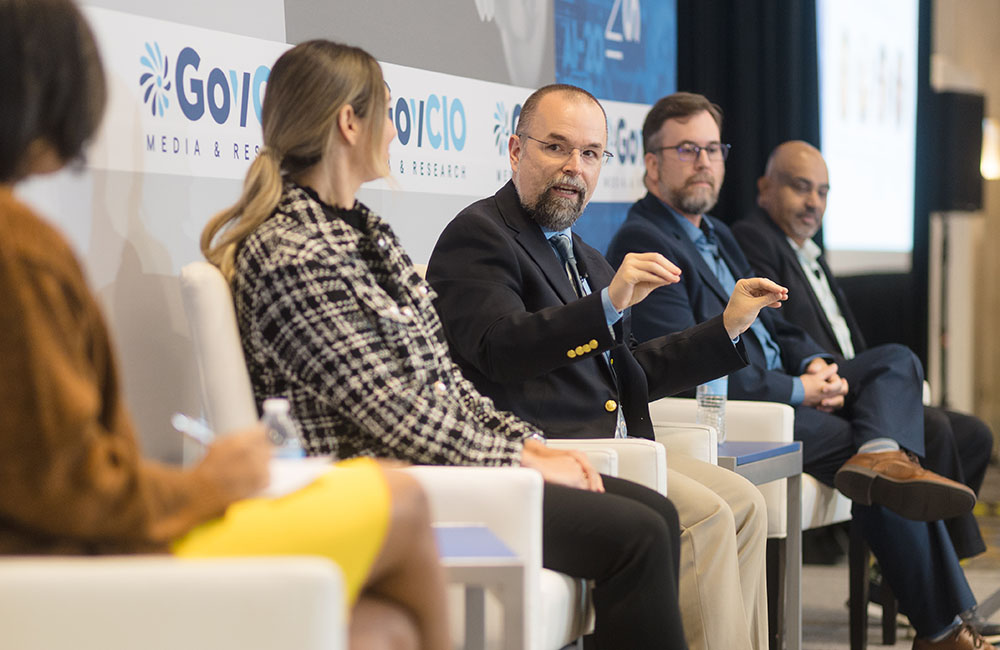Modernization Requires a Balance of Everyday Operations With Innovation

Balancing modernization and everyday operations is a challenge agencies consistently face. In the face of that, many departments across the federal government are focusing on shifting organizational and workforce needs, testing and agility to strike a balance.
At the National Institutes of Health’s Center for IT, COVID-19 showcased this necessity to triage IT resources and personnel to continue work amid new pandemic-induced challenges.
This led to a “strategic pause” for the office’s 2020 strategic modernization plans to support ongoing operations amid the pandemic, noted its Deputy Director Stacie Alboum.
“It’s actually better that we took that pause, because now we’re looking toward the future of work and supporting that vision and our people,” Alboum said at an ATARC event Tuesday. “We’re going to be shifting to some form of hybrid environment, and you can do hybrid well. You can do hybrid poorly. … We need to really take some time to assess and evaluate and experiment with what that looks like for NIH.
Alboum said that the new hybrid work environment that NIH is embracing has made her reconsider plans for both normal operations and modernization. This has included expanding and tweaking current operations and work, such as digital services, while also introducing new solutions to address upcoming needs, like making a hybrid work environment equitable through technology.
“This includes equitable access to the tools that people need to do their jobs and really thinking about all the populations as we implement more digital workplaces and shift to some form of hybrid,” Alboum said. “We are creating our vision for the future of work. … We’re really focused on flexibility because we have people where their work is not flexible.”
While most telework models are based on where employees are located, Alboum said NIH wants to move toward human-centric telework, meaning that the institutes want to not just enable flexibility about where their employees work, but when and how they work. This future-facing direction, she said, has required IT operations and transformation to meet NIH’s organizational and personnel needs.
Other agencies are also setting up their agencies to harmonize innovation and everyday enterprise support. The Department of Housing and Urban Development’s Ginnie Mae is doing this by testing innovative ideas in a testing environment before deploying new solutions across the agency.
Ginnie Mae has more specifically supported innovation testing with its Innovation Lab. The agency’s Emerging Technologies and Innovation Director Omar Bouaichi explained that the lab has enabled Ginnie Mae to continue normal operations while encouraging new ways to modernize.
“We have three distinct areas. One is running our operations. That needs to run without any disturbance, without any challenges,” Bouaichi said. “The other one is modernization, so modernization is bringing Ginnie Mae to the cloud and making sure that there is enhancement and that we’re keeping all the standard patching security requirements of our current systems. … The third area that we added is innovation. For us, we started our Innovation Lab, where we welcome the vendors, we welcome solutions that have not been tested, that needs to be assessed by Ginnie Mae so we can understand its impact.”
Bouaichi added that the Innovation Lab acts as a “safe area zone” for new solutions and technologies to come in. The lab applies innovative technologies to different use cases across Ginnie Mae to understand whether to deploy at scale across the agency. Since launching two years ago, the lab has tested and introduced new technologies to Ginnie Mae, like robotic process automation and machine learning.
While Ginnie Mae has its Innovation Lab, the Department of Transportation is using Agile methodology as its avenue for introducing new technologies while maintaining normal IT operations. The agency’s Principal Solutions Architect Edward Dowgiallo said that before COVID-19, his agency was relatively modernized, with its infrastructure largely in the cloud and applying Agile frameworks. With this in mind, his team dedicates time in their sprints to innovative.
“We make sure that there’s technical debt incorporated into every single spring, but 20% of the team’s work ideally goes towards other things, which can be, for example, innovation,” Dowgiallo said. “We might decide, rather than to spin out another contract, to use some of the existing cycles in that sprint to do RPA integration. That’s where we tested RPA for the first time to see how it would work with two systems talking to each other.”
Dowgiallo said that many of the innovative technologies his team introduces in their sprints start with smaller investments and grow iteratively with each cycle, allowing them to learn and respectively scale each time around.
This is a carousel with manually rotating slides. Use Next and Previous buttons to navigate or jump to a slide with the slide dots
-

AI Foundations Driving Government Efficiency
Federal agencies are modernizing systems, managing risk and building trust to scale responsible AI and drive government efficiency.
43m watch -

Inside DOD’s Push to Grow the Cyber Workforce Through Academia
Diba Hadi gives her first interview since becoming principal director of the DOD’s Cyber Academic Engagement Office.
15m listen -

Agencies Tackle Infrastructure Challenges to Drive AI Adoption
Federal agencies are rethinking data strategies and IT modernization to drive mission impact and operational efficiency as new presidential directives guide next steps.
5m read Partner Content -

Generative AI Demands Federal Workforce Readiness, Officials Say
NASA and DOI outline new generative AI use cases and stress that successful AI adoption depends on strong change management.
6m read -

The Next AI Wave Requires Stronger Cyber Defenses, Data Management
IT officials warn of new vulnerabilities posed by AI as agencies continue to leverage the tech to boost operational efficiency.
5m read -

Federal CIOs Push for ROI-Focused Modernization to Advance Mission Goals
CIOs focus on return on investment, data governance and application modernization to drive mission outcomes as agencies adopt new tech tools.
4m read -

Fed Efficiency Drive Includes Code-Sharing Law, Metahumans
By reusing existing code instead of rewriting it, agencies could dramatically cut costs under the soon-to-be-enacted SHARE IT Act.
5m read -

Agencies Push Data-Driven Acquisition Reforms to Boost Efficiency
New initiatives aim to increase visibility of agency spending, improve data quality and create avenues to deploy solutions across government.
5m read -

Data Transparency Essential to Government Reform, Rep. Sessions Says
Co-Chair of the Congressional DOGE Caucus Rep. Pete Sessions calls for data sharing and partnerships to reduce waste and improve efficiency.
5m read -

DOD Turns to Skills-Based Hiring to Build Next-Gen Cyber Workforce
Mark Gorak discusses DOD’s efforts to build a diverse cyber workforce, including skills-based hiring and partnerships with over 480 schools.
20m listen -

Trump Executive Order Boosts HBCUs Role in Building Federal Tech Workforce
The executive order empowers HBCUs to develop tech talent pipelines and expand access to federal workforce opportunities.
3m read -

Navy Memo Maps Tech Priorities for the Future Fight
Acting CTO’s memo outlines critical investment areas, from AI and quantum to cyber and space, as part of an accelerated modernization push.
5m read




